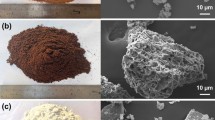Abstract
The results of studying the composition, structure, and properties of Kailinskoe clay are considered. The possibility for producing ceramic materials with a light-colored crock based on mineral material from the Siberian region is demonstrated.
Similar content being viewed by others
References
Production of Construction Ceramic Products. Current State and Prospects [in Russian], Gosstroiizdat, Moscow (1962).
G. V. Brindly, “Kaolinite, serpentinite, and related minerals,” in:X-Ray Analysis Methods and Structure of Argillaceous Minerals [Russian translation], Inostrannaya Literatura, Moscow (1965).
K. J. Hinckley, “Variability in crystallinity values among the kaolin deposits of the coastal plain of Georgia and South Carolina,” in:Clays and Clay Minerals, Proc. 11-th Conf. Clays and Clay Minerals (1963), pp. 229–235.
V. I. Vereshchagin, Yu. I. Alekseev, et al.,Diopside Rocks as Universal Material for Production of Ceramics and Other Silicate Materials [in Russian], Issue 2, VNIIÉSM, Moscow (1991).
V. I. Vereshchagin, L. Z. Reznitskii, E. P. Vasiliev, and Yu. I. Alekseev, “Diopside rocks as multi-purpose material,”Steklo Keram., No. 1, 18–19 (1989).
Author information
Authors and Affiliations
Additional information
Translated from Steklo i Keramika, No. 8, pp. 12–15, August, 1999.
Rights and permissions
About this article
Cite this article
Vakalova, T.V., Khabas, T.A., Vereshchagin, V.I. et al. Promising argillaceous materials for fine and structural ceramics. Glass Ceram 56, 245–248 (1999). https://doi.org/10.1007/BF02681504
Issue Date:
DOI: https://doi.org/10.1007/BF02681504




